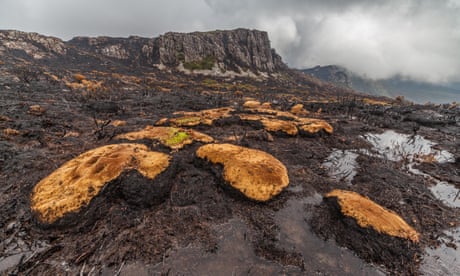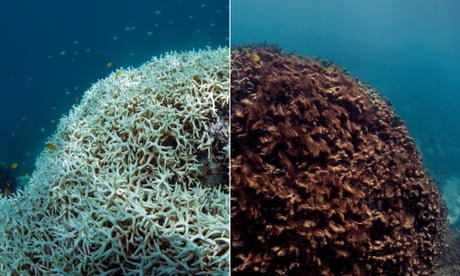
Australia’s extreme weather in 2016 was driven by humankind’s burning of fossil fuels as well as a strong El Niño. Photograph: Tracey Nearmy/AAP
Bureau of Meteorology’s annual climate statement cites unprecedented bushfires in regions that don’t usually burn and worst coral bleaching on record...
Australia’s weather was extreme in 2016, driven by humankind’s burning of fossil fuels as well as a strong El Niño, according to the Bureau of Meteorology’s annual climate statement.
That extreme weather led to devastated ecosystems both on land and in the sea, with unprecedented bushfires in regions that don’t usually burn, the worst coral bleaching on record, and has been attributed as the cause of damage to vast tracts of crucial kelp forests, oyster farms and salmon stocks across southern Australia.
The statement, released on Thursday, said the country as a whole had its fourth-warmest year on record, but locally, Sydney and Darwin broke records for both their hottest maximum temperatures and hottest minimum temperatures.
Hobart had its warmest night on record in 2016 and both Hobart and Brisbane had records for their hottest annual mean temperature fall as well. The hot and dry start to the year sparked bush fires in Victoria, Tasmania and Western Australia.

While land burned, the sea around Australia broiled. The bureau’s statement said despite the surface temperature of the seas around Australia being consistently high in recent years, 2016 reached a new record temperature, being 0.73C above the 1961-90 average.
Off the coast of Queensland, those record temperatures led to the worst coral bleaching on record, where an estimated 22% of the coral on the entire 2,300km length of the Great Barrier Reef was lost.
In the northern, most remote and most pristine part of the reef, coral was devastated by the unusually warm water, which scientists say will become the norm in fewer than 20 years.
The bureau’s statement also notes that ocean temperatures were at record highs around Tasmania in 2016. The freakishly hot waters there have been attributed as the cause of damage to oyster, salmon and abalone industries, as well as increased stress to kelp forests, already devastated by warmer waters in recent years.
The record hot waters in Tasmania were caused by a strengthened east Australian current, which drags warm waters from the tropics, along the coast of Australia. “This was associated with the longest and most intense marine heatwave on record for the south-east Australian region,” the statement said.
It added: “The pattern of above average temperatures over land and in the oceans reflects the background warming trend. The Australian climate in 2016 was influenced by a combination of natural drivers and anthropogenic climate change.”
The hot temperatures around the country were followed up by unusually wet conditions for much of Australia too.
The bureau said Adelaide had its second-wettest year on record and its wettest since 1992. Sydney, Canberra and Hobart had above average rainfall. But the pattern wasn’t uniform, as Perth and Melbourne were close to average and Darwin and Brisbane were significantly drier than average in 2016.
“Widespread, drought-breaking rains led to flooding in multiple states,” said Neil Plummer from the Bureau of Meteorology. “Even northern Australia saw widespread rainfall, during what is usually the dry season, greening regions that had been in drought for several years.”
The BOM’s Annual Climate Statement is a snapshot of the Australian climate for the previous year including rainfall, temperature and significant events...
Wednesday 4 January 2017 19.37 EST
source: https://www.theguardian.com/us
original story HERE
To help do something about the climate change and global warming emergency, click here.
Sign up for our free Global Warming Blog by clicking here. (In your email, you will receive critical news, research, and the warning signs for the next global warming disaster.)
To share this blog post: Go to the Share button to the left below.


Be the first to comment
Sign in with